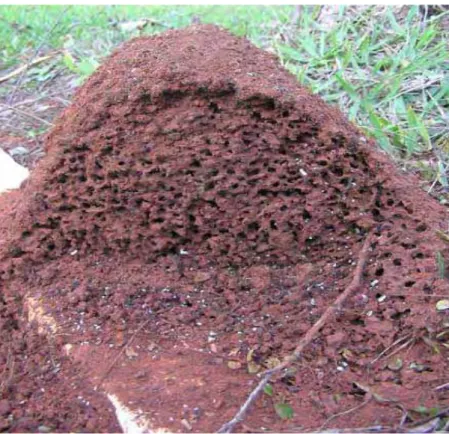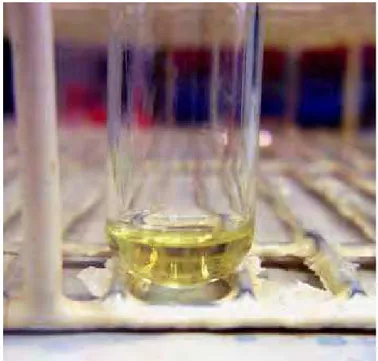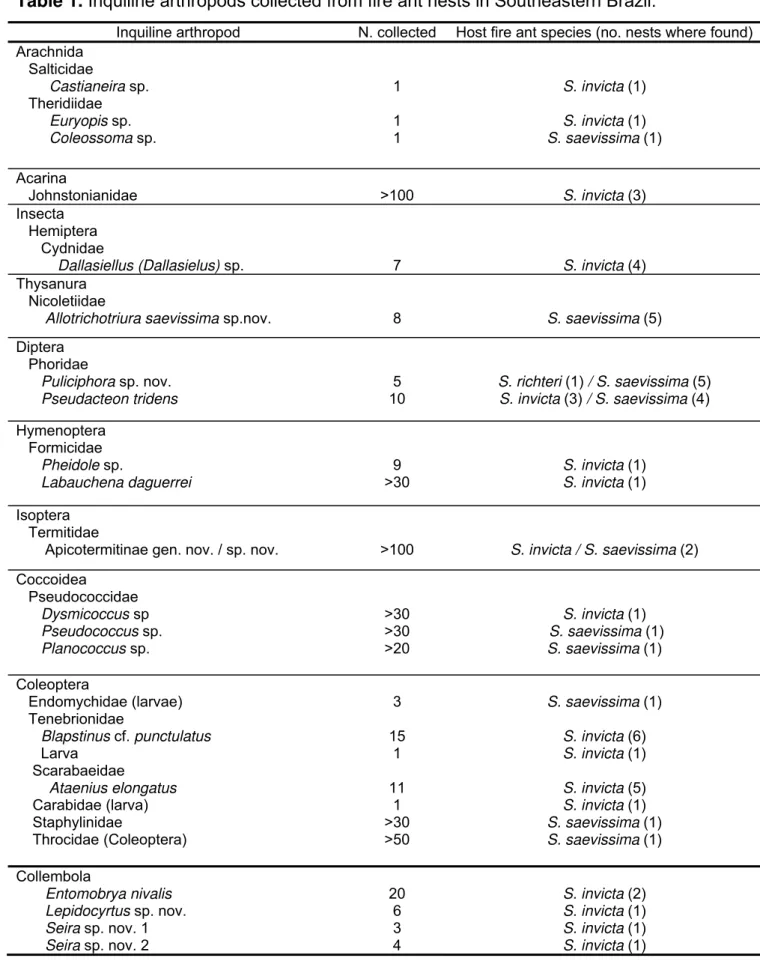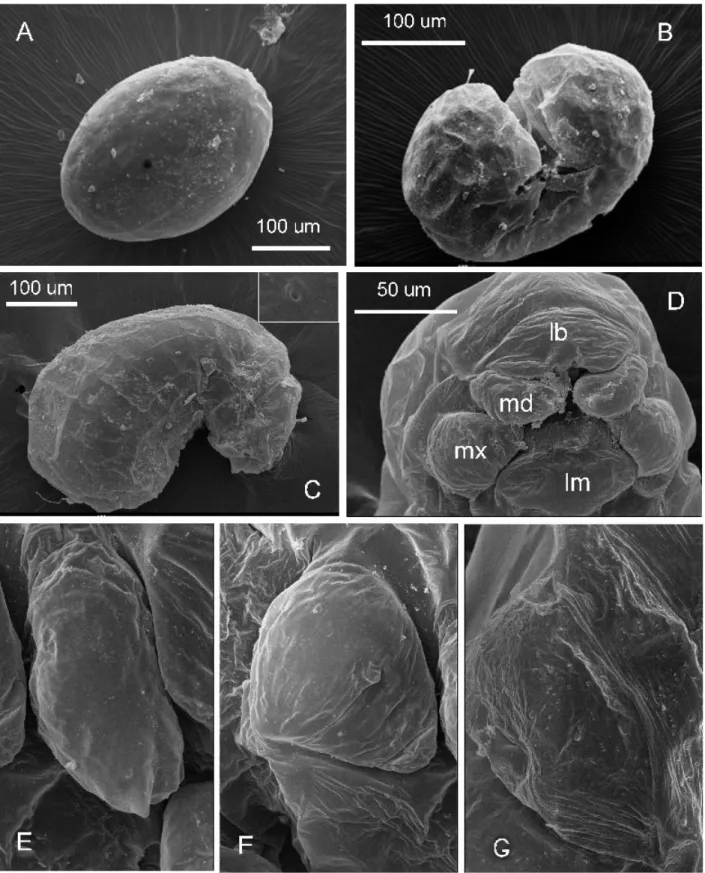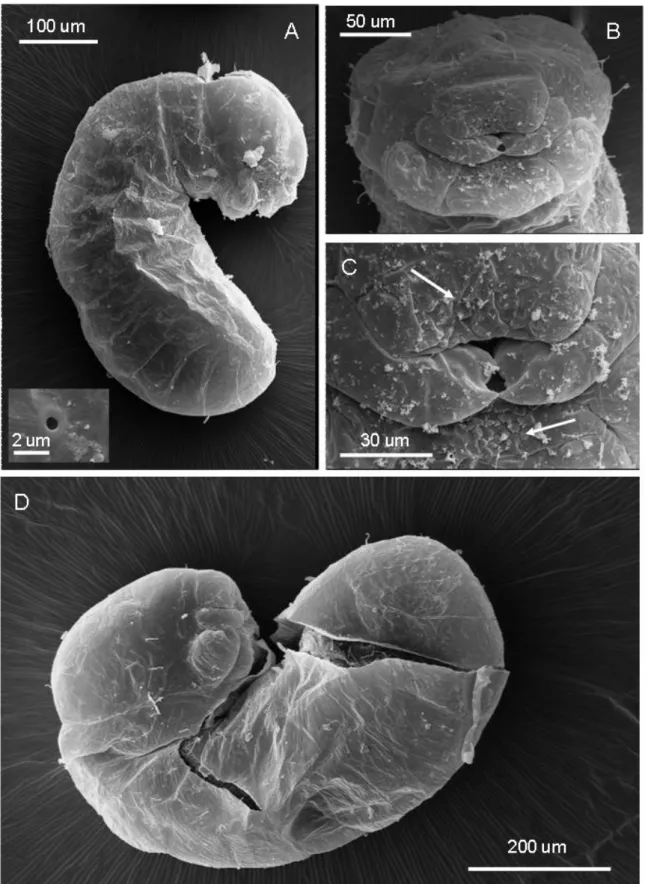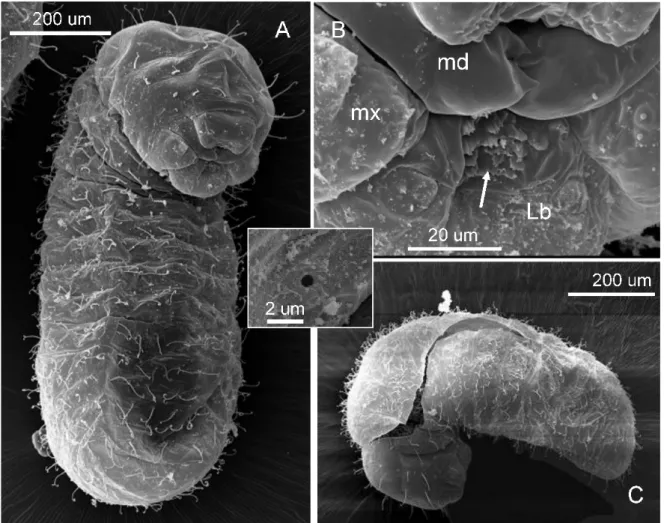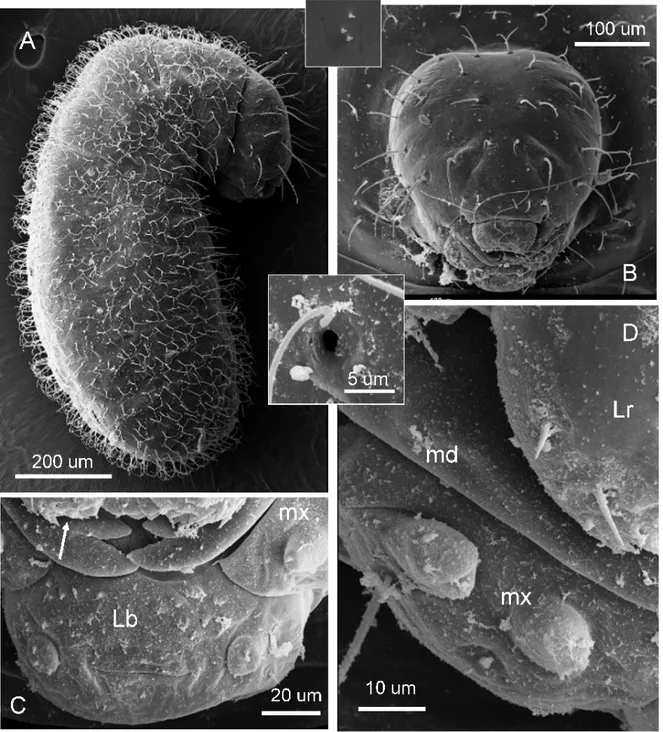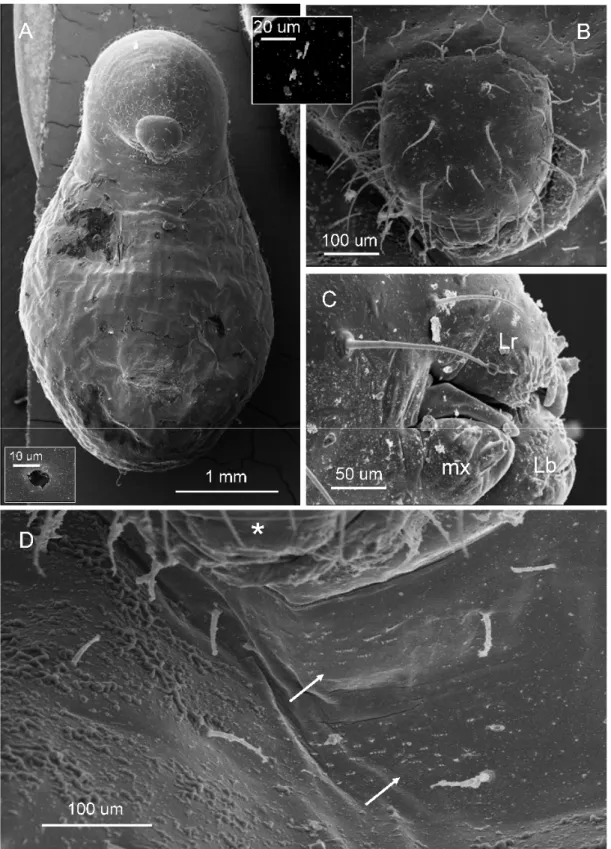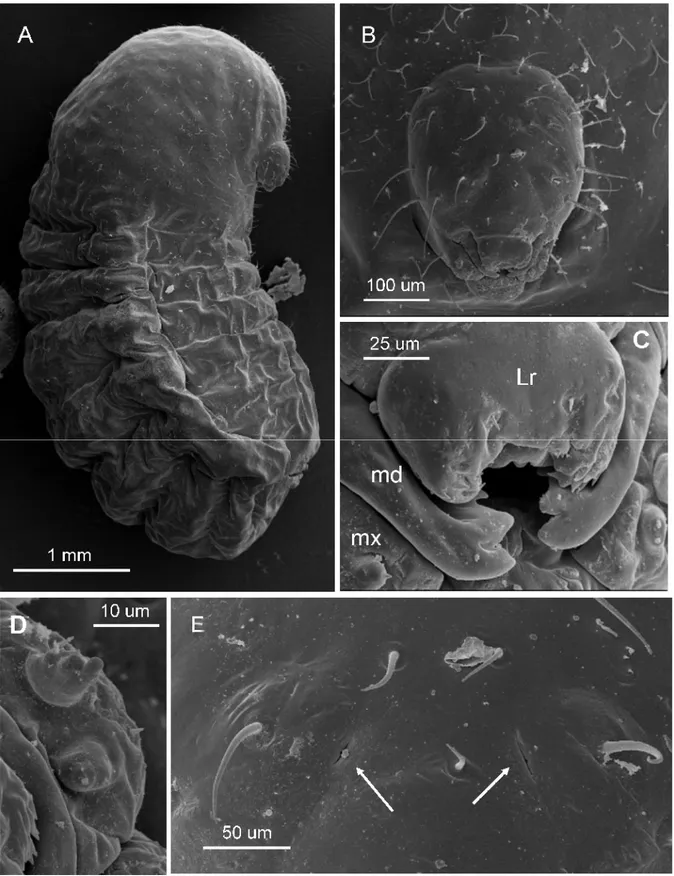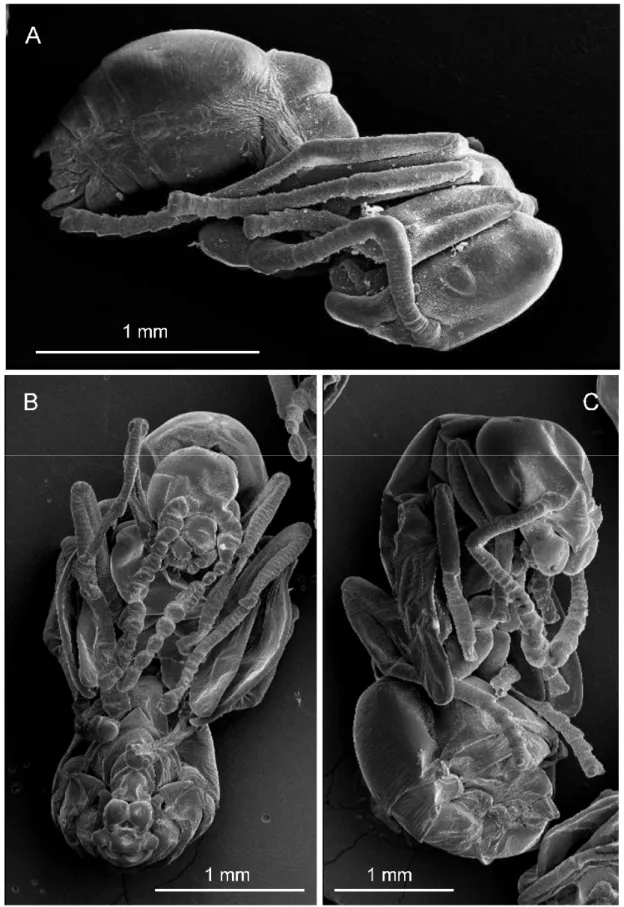UNIVERSIDADE ESTADUAL PAULISTA “JÚLIO DE MESQUITA FILHO”
INSTITUTO DE BIOCIÊNCIAS – RIO CLARO
unesp
PROGRAMA DE PÓS-GRADUAÇÃO EM CIÊNCIAS BIOLÓGICAS (ZOOLOGIA)
BIOLOGIA, MORFOLOGIA, E BIOQUÍMICA DE VENENO DA FORMIGA LAVA-PÉSSolenopsis saevissimaSmith
(INSECTA: HYMENOPTERA: FORMICIDAE)
EDUARDO GONÇALVES PATERSON FOX
Tese apresentada ao Instituto de Biociências do Câmpus de Rio Claro, Universidade Estadual Paulista, como parte dos requisitos para obtenção do título de Doutor em Ciências Biológicas (área de concentração: Zoologia).
FORMIGA LAVA-PÉS
Solenopsis saevissima
Smith
(INSECTA, HYMENOPTERA, FORMICIDAE)
EDUARDO GONÇALVES PATERSON FOX
Orientador: Prof. Dr. Odair Correa Bueno
Tese apresentada ao Instituto de Biociências do Campus de Rio Claro, Universidade Estadual Paulista Júlio de Mesquita Filho, como parte dos requisitos para obtenção do título de Doutor em Ciências Biológicas (Área de Zoologia)
Rio Claro
Fox, Eduardo Gonçalves Paterson
Biologia, morfologia e bioquímica de veneno da formiga lava-pés, Solenopsis saevissima Smith (Insecta:
Hymenoptera: Formicidae) / Eduardo Gonçalves Paterson Fox. - Rio Claro : [s.n.], 2010
123 f. : il., figs., tabs.
Tese (doutorado) - Universidade Estadual Paulista, Instituto de Biociências de Rio Claro
Orientador: Odair Correa Bueno
1. Formiga. 2. Formigas - História natural. 3. Formiga de fogo. 4. Toxina. 5. Formigueiro. 6. Larva. 7. Alcalóide. I. Título.
595.796 F791b
ii
AGRADECIMENTOS
Aos meus orientadores por terem me ajudado neste longo e difícil processo de investigação.
Aos colaboradores desta pesquisa, provenientes de diversas instituições (em especial CEIS/UNESP, NAP/NEPA/ESALQ, CENA/USP, IQ/UNICAMP, MZUSP, IBCCF/UFRJ) que participaram de cada momento das descobertas em suas respectivas áreas, contribuindo para a formação do panorama geral como aqui apresentado.
Aos colegas de instituição pelos momentos de trabalho e lazer proporcionados, bem como ajuda nas coisas mais simples mas que são tão importantes.
Aos amigos e companheiros que ganhei me deslocando de longe para outra cultura, pela troca de idéias e momentos prazerosos.
Aos amigos mais chegados, por definição tão poucos e tão valiosos, pelos momentos inesquecíveis juntos e por nunca terem me abandonado nas horas mais difíceis.
Finalmente, agradeço a todos aqueles que de alguma forma estiveram presentes em minha vida nestes últimos anos. Todos de alguma forma contribuem para os resultados aqui apresentados e para tudo que for acontecer de aqui para adiante, no verdadeiro início da minha vida profissional.
“This species [Solenopsis saevissima] is exclusively found in sandy soils, in open
semi-cultivated or neglected places […] they increase only in the neighbourhood of
deserted houses or unweeded plantations; consequently they are a scourge only to
the lazy and worthless people that inhabit the shores of this magnificent river.”
Henry Bates, O Naturalista no Rio Amazonas (1855). Escrito cerca de 100 anos
iv
RESUMO
A formiga lava-pés Solenopsis saevissima Smith está entre os insetos que
mais causam acidentes no Brasil, e é uma espécie pouco estudada. A presente série de investigações tenta suprir um pouco da necessidade de estudos com esta importante espécie no Brasil. Primeiramente são relatados detalhes da biologia de S.
saevissima em comparação com outras espécies de formigas lava-pés: pela primeira
vez é mostrada uma lista de artrópodes associados a estes formigueiros no Brasil, incluindo uma série de novos táxons, dos quais um é aqui descrito; as larvas desta espécie são descritas e comparadas com o que se sabe sobre as larvas de outras lava-pés, sendo visto que as semelhanças encontradas são extensas demais para permitir a utilização de caracteres larvais para filogenia e taxonomia em nível de espécie. Ainda na morfologia, são apresentados resultados de análise ultraestrutural do aparato de veneno por meio de microscopia ótica e eletrônica, onde é mostrado que as diferentes regiões do órgão apresentam especializações para a produção de cada um dos compostos do veneno. A composição do veneno desta espécie foi analisada pela primeira vez, onde verificou-se que acima de 90% do veneno de S.
saevissima é composto de isômeros cis e tras de um mesmo alcalóide piperidinico
oleoso, sendo o restante uma solução aquosa de toxinas protéicas, incluindo neurotoxinas, fosfolipases, e alérgenos. De uma forma geral, o veneno de S.
saevissima tem uma diversidade menor de compostos que o de Solenopsis invicta,
podendo figurar entre os motivos que explicam porque a espécie S. invicta é uma
espécie invasora e S. saevissima não. São apresentados pela primeira vez
evidências químicas da existência de espécies crítpticas dentro de S. saevissima.
Tomados em conjunto, os resultados suprem um pouco da carência de estudos com as formigas lava-pés na América do Sul e demonstram a diversidade de assuntos ainda a serem investigados nestes insetos.
ABSTRACT
The fire ant Solenopsis saevissima Smith is one of the insects most frequently
involved in accidents in Brazil, yet being a poorly studied species. The series of studies presented here aimed at filling some of this gap in knowledge about this common and important ant species. Some aspects of the field biology of S.
saevissima are shown in comparison with other fire ants: a unique list of associated
arthropods collected from field inspections in Southern Brazil is given, which includes several new taxa, one of which is herein described for the first time. The larvae of S.
saevissima are described for the first time and compared with larvae from close
species, culminating with the demonstration that larval characters within this group cannot be feasibly employed in species-level phylogenetic and taxonomic analyses. In terms of internal anatomy, a detailed ultrastructural description of the venom apparatus of S. saevissima is given, wherein special emphasis was given to the
particular organisation of each region of the apparatus, suggesting there are specialised areas for the production of each venom compound. The venom of this species was subject of biochemical analyses for the first time, generally illustrating that the venom of S. saevissima is >90% made of a simple mixture of cis- and
tras-undecil-pyperidinic alkaloids, being the remainder an aqueous solution of toxic proteins, comprising neurotoxins, and traces of phospholipases and allergens. The venom of S. saevissima proved being less diverse in toxins than the venom of
Solenopsis invicta, possibly explaining why S. invicta is a successful invasive species
whileS. saevissima apparently is not. Moreover, herein is included the first record of
intraspecific variation in the nature of venom alkaloids, providing biochemical evidence for the existence of cryptic species in S. saevissima. Taken together, the
obtained results contribute to the body of knowledge about fire ant populations in South America, and are proof of the existence of paramount facets yet to be investigated in deeper details.
vi
Organização da tese
Esta tese teve como objetivo geral apresentar resultados sobre vários aspectos da biologia e bioquímica de veneno das formigas lava-pés, em especial S.
saevissima. Estes resultados foram aqui agrupados em capítulos individualizados de
acordo com o assunto de que tratam. Cada capítulo já foi escrito e organizado em formato de publicação, logo todos estão no idioma internacional inglês e incluem resumo, introdução, discussão e conclusões próprias. Ao fim da tese, panorama geral sobre as partes é traçado para que se possa avaliar o que foi obtido no conjunto, e uma série de perspectivas futuras são delineadas.
O capítulo 1 apresenta uma lista de artrópodes inquilinos encontrados no interior dos formigueiros de lava-pés durante as coletas no campo, bem como faz comentários sobre a distribuição das espécies nas áreas investigadas. É enfatizada a carência de estudos de biologia geral com as formigas lava-pés no Brasil, inclusive constando na lista um grande número de espécies de artrópodes desconhecidas ou raramente encontradas na literatura.
O capítulo 2 apresenta uma descrição morfológica detalhada de uma destas novas espécies, pertecente a um novo gênero de tisanuros (traças) do Brasil.
O capítulo 3 apresenta a morfologia de todos os estádios imaturos de S.
saevissima com imagens detalhadas de microscopia eletrônica de varredura, e
discute as características observadas em comparação com outras espécies para determinar a relevância para a taxonomia do grupo.
O capítulo 4 aborda a estrutura do aparato de veneno e de cada uma de suas partes, em comparação com o que foi feito com outras espécies de formigas lava-pés.
O capítulo 5 relata os resultados sobre os alcalóides de veneno e hidrocarbonetos cuticulares obtidos para S. saevissima, bem como fornece fortes
evidências da existência de espécies crípticas, ilustrando como maiores estudos podem influenciar a sistemática atual do grupo.
SUMÁRIO Página Introdução Objetivos Capítulo 1. Capítulo 2. Capítulo 3. Capítulo 4. Capítulo 5. Capítulo 6. Conclusões Gerais Perpectivas Futuras ... ...
Uma lista preliminar dos inquilinos encontrados dentro de formigueiros de lava-pés no Sudeste do Brasil...
Sobre um novo Nicoletiidae (Zygentoma: Insecta) do Brasil vivendo com formigas lava-pés (Hymenoptera: Formicidae)...
Sobre as larvas da formiga lava-pés Solenopsis saevissima. ...
Morfologia geral e ultraestrutural do aparato de veneno da formiga lava-pés Solenopsis saevissima...
Caracterização dos alcalóides de veneno e hidrocarbonetos cuticulares da formiga lava-pés
Solenopsis saevissima...
Sobre as proteínas de veneno das formigas lava-pés: Análise proteômica do veneno de Solenopsis invicta e
Introdução
As formigas lava-pés
O gênero Solenopsis inclui cerca de 277 espécies (BOLTON, 2006) de
ocorrência mundial, sendo que umas vinte destas são espécies maiores e mais agressivas conhecidas como “formigas lava-pés” ou “formigas de fogo”, por causa da dor causada por suas ferroadas. Estas formigas são únicas entre os artrópodes por possuirem uma mistura de alcalóides em seus venenos aliados a uma pequena quantidade de proteínas alergênicas, sendo esta combinação responsável pelos incômodos gerados pelas ferroadas.
As formigas lava-pés apresentam ampla ocorrência no território brasileiro, inclusive dentro das zonas urbanas, onde ocorrem principalmente nas beiras de estradas e gramados.
As formigas lava-pés são onívoras e oportunistas, que podem predar tanto vertebrados e invertebrados quanto plantas (VINSON, 1994), além de terem o hábito de complementar sua dieta com secreções provenientes de outros invertebrados como, por exemplo, os insetos sugadores de seiva conhecidos como afídios (GREEN, 1952). Os ninhos são construídos diretamente no chão, em áreas abertas e ensolaradas, constituídos basicamente de um monte de terra no interior do qual fica a colônia, da qual irradiam vários túneis de forrageio (PORTER; TSCHINKEL, 1987, ver Figura 1).
Devido à sua agressividade, proximidade dos ninhos das habitações humanas, e ao hábito de se associar a insetos sugadores de seiva, uma série de problemas são gerados pela presença das formigas lava-pés, que vão desde acidentes com animais e populações até estragos gerados na agricultura (LOFGREN et al., 1975). Algumas espécies de lava-pés foram acidentalmente transportadas a partir do Brasil para outras partes do mundo através de navios carregando madeira (TABER, 2000). Dentre estas, a espécie Solenopsis invicta
Buren é a que causa mais estragos em todos os países em que se estabeleceu, gerando graves problemas de saúde e agrícolas com prejuízos elevados, sendo atualmente um dos insetos invasores mais importantes do mundo (HENSHAW et al., 2005).
As espécies de formigas lava-pés mais comuns no Brasil são S. invicta e
9
país (ROSSI; FOWLER, 2004). Apesar de causar muitos acidentes na região Amazônica, sendo considerada uma séria praga em algumas localidades (LUNZ et al., 2009), a espécie S. saevissima nunca foi registrada como invasora em outros
países. Como uma consequência de sua importância social mais restrita, esta espécie não é bem conhecida e estudada como é a espécie invasora S. invicta,
havendo uma grande carência de conhecimento em vários aspectos de sua biologia.
A problemática na distinção entre espécies de formigas lava-pés
As espécies de formigas lava-pés são difíceis de se determinar por morfologia devido aos caracteres serem variáveis e inconspícuos, além de haver um número ainda indeterminado de espécies intercruzantes (PITTS et al., 2005; VANDER MEER; LOFGREN, 1985; TRAGER, 1991). As diferentes espécies de formigas lava-pés são todas polimórficas e de morfologia bastante semelhante, sendo este grupo considerado um dos mais controversos quanto à sistemática e a filogenia (PITTS et al. 2005). Os caracteres morfológicos empregados na separação das espécies são de difícil observação e a morfologia destes caracteres apresenta um grau considerável de variação intraespecífica, e às vezes, dentro de uma mesma colônia (PITTS et al., 2005, vide alguns caracteres na Figura 2). A problemática é tornada mais difícil pela existência de espécies intercruzantes e até de espécies não descritas (PITTS et al., 2005). Sendo assim, a identificação da espécie de uma
amostra de lava-pés depende da opinião de um especialista experiente com o grupo, sendo não raro impossível, dependendo das condições da amostra.
Acredita-se que ferramentas moleculares tais como aloenzimas, marcadores de mt-RNA, determinação de hidrocarbonetos de cutícula e composição bioquímica de venenos, possam auxiliar grandemente na separação de espécies dentro deste grupo de difícil classificação (VANDER MEER; LOFGREN, 1998; STEINER et al., 2002; ROSS; SHOEMAKER, 2005). Uma destas ferramentas são os hidrocarbonetos cuticulares, satisfatoriamente já aplicados na separação entre S.
invicta e Solenopsis richteri Forel 1923, duas espécies muito semelhantes, tendo
sido a mesma ferramenta utilizada para demonstrar que há hibridização entre estas duas espécies (VANDER MEER; LOFGREN, 1985).
MEER; LOFGREN, 1985; DALL’AGLIO-HOLVORCEM, 2006; Figura 4), uma vez que as espécies mais estudadas apresentaram padrões de alcalóides de veneno distintos e específicos. Recentemente, um estudo demonstrou a utilidade dos hidrocarbonetos e destes na distinção entre populações de S. invicta e S. saevissima
dentro do Estado de São Paulo, Brasil (DALL’AGLIO-HOLVORCEM et al., 2009). Como as proteínas de veneno são, em princípio, mais difíceis de se obter por estarem presentes em quantidades diminutas, e não foram estudadas em diferentes espécies, sua aplicabilidade na sistemática e taxonomia ainda permanece uma incógnita.
No tocante ao caso específico da espécie-alvo do presente estudo, S.
saevissima, um artigo recente apontou a existência de mais de um haplótipo dentro
desta espécie baseado na estrutura molecular de populações de S. saevissima de diversas regiões da América do Sul, sugerindo a existência de espécies crípticas. Estas espécies são morfologicamente idênticas, porém podem ter características fisiólogicas distintas, como por exemplo, a composição de venenos. De posse desta informação, a presente investigação restringiu as análises e estudos às populações de S. saevissima de uma única região geográfica fixa, onde as amostras coletadas
apresentassem os mesmos alcalóides de veneno.
O veneno das formigas lava-pés
Os constituintes do veneno dos insetos himenópteros são produzidos por duas glândulas exócrinas anexas ao ferrão: a glândula ácida (ou glândula de veneno) e a glândula básica (ou glândula de Dufour) (CRUZ-LANDIM; ABDALLA, 2002; BILLEN et al., 2000). O conjunto destas glândulas e mais o reservatório de veneno é denominado de aparato de veneno. Conforme mencionado anteriormente e discutido em maiores detalhes adiante, o veneno das formigas lava-pés é uma mistura de uma grande quantidade de alcalóides (>90%) com uma solução aquosa de proteínas alergênicas.
11
atacam agarrando-se firmemente à pele da vítima com as mandíbulas e ferroando repetidas vezes, em um padrão de movimento circular (HOFFMAN, 1995).
Geralmente as ferroadas causam reações desagradáveis passageiras, como dor no momento da picada (reação atribuída aos alcalóides) seguida de queimação e forte coceira local (reação atribuida aos alérgenos). A maioria dos acidentes ocorre por contato direto com o formigueiro, onde uma grande quantidade de formigas pode estar envolvida no acidente. Dependendo do número de ferroadas e da sensibilidade da vítima aos compostos do veneno, a situação do paciente pode evoluir para quadros mais graves, como coceira pelo corpo inteiro, inchaço do membro atacado, necrose de tecido e até choque anafilático seguido de dificuldade de respiração, estado de coma ou morte (DESHAZO et al., 1984; STABLEIN; LOCKEY, 1987; RHOADES et al., 1989; PRAHLOW; BARNARD, 1998).
A maioria das informações sobre os venenos das lava-pés é originária de estudos norte-americanos com a espécie invasora S. invicta, devido à sua importância local conforme comentado. Também existem alguns estudos sobre poucas outras espécies de formigas lava-pés (BLUM et al., 1961; CRUZ-LOPES et al. 2001; BLUM et al., 1974; JONES et al. 1996; JONES; BLUM, 1982). No Brasil as espécies S. invicta e S. saevissima são as mais abundantes, e há locais onde
inclusive há predominância de S. saevissima (ROSSI e FOWLER, 2004; LUNZ et al.,
2009). Sendo assim, uma grande parte dos acidentes com himenópteros no Brasil são causados pela espécie S. saevissima, porém não há nenhum estudo na
literatura sobre o veneno desta espécie.
atividade antifúngica e antimicrobiana, além de outras pronunciadas atividades biológicas sobre o sistema circulatório, nervoso e imune de vertebrados (vide HOWELL et al., 2005).
Uma ferroada de uma formiga lava-pé injeta cerca de 20nl contendo 10-100ng de proteína (HOFFMAN et al., 1988). O veneno possui apenas 0,1-1% (p/v) de uma solução aquosa de proteínas (BAER et al., 1979), sendo que o restante (acima de 90%) do veneno se consiste de alcalóides piperidinas insolúveis em água (n-alquil e alcenil). Os alcalóides são responsáveis pela queimação e formação de pústulas na ferroada (JUNG et al., 1963), enquanto que as proteínas geram as reações alérgicas que podem variar de intensidade conforme a sensibilidade da vítima.
As proteínas de veneno das formigas lava-pés figuram entre os alérgenos mais potentes do mundo (SCHMIDT et al., 1998), porém poucos estudos foram feitos com estas proteínas devido à sua ínfima quantidade no veneno e às dificuldades de se obter veneno de formigas em grandes quantidades. Ainda assim, foram isolados e caracterizados quatro alérgenos do veneno de S. invicta
(HOFFMAN et al., 1988; HOFFMAN, 1993a), chamados de Sol i 1, Sol i 2, Sol i 3 e Sol i 4. O alérgeno Sol i 1 é a proteína de maior peso molecular (~34kDa) e está presente em menor quantidade no veneno (de 2-5%); possui atividade como fosfolipase A1B (HOFFMAN et al. 1988). O alérgeno Sol i 3 costuma ser bastante abundante (67%), sendo um dímero de 26kDa formado de dois monômeros de 13kDa. Os demais alérgenos Sol i 2 e Sol i 4 formam juntos cerca de 15-20% do veneno e ambos possuem cerca de 15kDa de peso molecular (HOFFMAN, 1993b).
A literatura científica reporta o estudo das proteínas de veneno de apenas uma outra espécie de formiga lava-pes, Solenopsis richteri, que possui compostos
13
OBJETIVOS
Objetivo Geral:
Agregar conhecimento sobre a biologia, morfologia e bioquímica de veneno deS. saevissima, dado que esta foi pouco estudada até o momento.
Objetivos específicos:
•Levantar os dados biológicos e morfólogicos existentes na literatura sobre S.
saevissima.
• Obter dados de biologia de campo de S. saevissima
• Descrever os estádios imaturos de S. saevissima por meio de análise por
micoscopia ótica e de varredura.
• Descrever o aparato de veneno de operárias de S. saevissima utilizando
histologia e micrografias óticas e eletrônicas de transmissão e varredura.
• Investigar os alcalóides presentes no veneno de S. saevissima e compará-los com aqueles de outras espécies de formigas lava-pés estudadas.
• Determinar a natureza das proteínas de veneno da espécie S. saevissima, e
Figura 1. Exemplo de um formigueiro de lava-pés, seccionado ao meio para exibir a estrutura interna de túneis. Os corpúsculos brancos são os estágios imaturos das formigas.
15
Figura 3. Micrografia eletrônica das peças bucais de uma operária maior de Solenopsis saevissima, evidenciando características da espécie, como costuras completas da mandíbula e grau de desenvolvimento do dente mediano do clípeo (centro da imagem).
Referências
BAER, H.; LIU, T.Y.; ANDERSON, M.C.; BLUM, M.; SCHMIDT, W.H.; JAMES, F.J. protein components of the fire ant venom (Solenopsis wagneri). Toxicon, v. 17, p.
397-405, 1979.
BILLEN, J.; ITO, F.; TSUJI, K.; SCHOETERS, E.; MAILE, R.; MORGAN, D. Structure and chemistry of the Dufour gland in Pristomyrmex ants (Hymenoptera,
Formicidae).Acta Zoologica, v. 81, p. 159-166, 2000.
BLUM, M. S.; WALKER, J. R.; CALLAHAN, P. S.; NOVAK, A. F. Chemical, insecticidal, and antibiotic properties of fire ant venom. Science, v. 128, p. 306-307, 1958.
BLUM, M. S.; ROBERTS, J. R.; NOVAK, A. F. Chemical and biological characterization of venom of the ant Solenopsis xyloni McCook. Psyche, v. 68, p. 73-74, 1961.
CHEN, L.; FADAMIRO, H. Y. Re-investigation of venom chemistry of Solenopsis fire ants. I. Identification of novel alkaloids in S. richteri. Toxicon, v. 53, p. 469-478, 2009a.
CHEN, L.; FADAMIRO, H. Y. Re-investigation of venom chemistry of Solenopsis fire
ants. II. Identification of novel alkaloids in S. invicta. Toxicon, v. 53, p. 479-486,
2009b.
CRUZ-LANDIM, C.; ABDALLA, F. C. Glândulas exócrinas das abelhas. FUNPEC, São Paulo, 181 pp., 2002.
CRUZ-LOPEZ, L.; ROJAS, J. C.; CRUZ-CORDERO, R. L.; MORGAN, E. D. Behavioral and chemical analysis of venom gland secretion of queens of the ant
Solenopsis geminata.Journal of Chemical Ecology, v. 27, p. 131-140, 2001.
17
fenologia de seus parasitóides do gênero Pseudacteon (Diptera: Phoridae). Tese de Doutorado apresentada ao Dept. de Ecologia. UNICAMP, Campinas, 135 pp., 2006.
DALL’AGLIO-HOLVORCEM, C. G.; BENSON, W. W.; GILBERT, L. E.; TRAGER, J. C.; TRIGO, J. R. Chemical tools to distinguish the fire ant species Solenopsis
invicta and S. saevissima (Formicidae: Myrmicinae) in Southeast Brazil.
Biochemical and Systematic Ecology, v. 37, p. 442-451, 2009.
DESHAZO, R. D.; GRIFFING, C.; KWAN, T. H.; BANKS, W. A.; DVORAK, H. F. Dermal hypersensitivity reactions to imported fire ants. Journal of Allergy and Clinical Immunology, v. 74, p. 841-847, 1984.
GORMAN, J. S. T.; JONES, T. H.; SPANDE, T. F.; SNELLING, R. R.; TORRES, J. A.; GARRAFFO, H. M. 3-Hexyl-5-methylindolizidine isomers from thief ants,
Solenopsis (Diplorhoptrum) species. Journal of Chemical Ecology, v. 24, p.
933-943, 1998.
GREEN, H. B. Biology and control of the imported fire ant in Mississippi. Journal of Economical Entomology, v. 45, p. 593-597, 1952.
HENSHAW, M. T.; KUNZMANN, N.; VANDERWOUDE, C.; SANETRA, M.; CROZIER, R. H. Population genetics and history of the introduced fire ant,
Solenopsis invicta Buren (Hymenoptera: Formicidae), in Australia. Australian
Journal of Entomology, v. 44, p. 37-44, 2005.
HOFFMAN, D. R.; DOVE, D. E.; JACOBSON, R. S. Allergens in Hymenoptera venom XX. Isolation of four allergens from imported fire ant (Solenopsis wagneri)
venom.Journal of Allergy and Clinical Immunology, v. 82, p. 818-827, 1988.
HOFFMAN, D. R. Allergens in Hymenoptera venom XXV. The amino acid sequences of antigen 5 molecules and structural basis of antigenic cross-reactivity. Journal of Allergy and Clinical Immunology, v. 92, p.707-716, 1993b.
HOFFMAN, D. R. Fire ant allergy. Allergy, v. 50, p. 535-544, 1995.
HOWELL, G.; BUTLER, J.; DESHAZO, R.D.; FARLEY, J. M.; LIU, H. L.; NANAYAKKARA, N. P. D.; YATES, A.; YI, G. B.; ROCKHOLD, R. W. Cardiodepressant and neurologic actions of Solenopsis invicta (imported fire ant)
venom alkaloids. Annals of Allergy and Asthma Immunology, v. 94, p. 380-386, 2005.
JONES, T. H.; BLUM, M. S. Ant venom alkaloids from Solenopsis and Monomorium
species.Tetrahedron, v. 38, p.1949-1958, 1982.
JUNG, R. C.; DERBES, V. J.; BURCH, A. D. Skin response to solenamine, a hemoloytic component of fire-ant venom. Dermatologica Tropica, v. 2, p. 241-244, 1963.
LECLERCQ, S.; THIRIONET, I.; BROEDERS, F.; DALOZE, D.; VAN DER MEER, R.; BRAEKMAN, J. C. Absolute configuration of the solenopsins, venom alkaloids of the fire ants. Tetrahedron, v. 50, p. 8465-8478, 1994.
LOFGREN, C. S.; BANKS, W. A.; GLANCEY, B. M. Biology and control of imported fire ants. Annual Reviews in Entomology, v. 20, p. 1-30, 1975.
LUNZ, A. M.; HARADA, A. Y.; AGUIARI, T. S., CARDOSO, A. S. Danos de
Solenopsis saevissima F Smith (Hymenoptera: Formicidae) em Paricá,
Schizolobium amazonicum.Neotropical Entomology, v..38, p. 23-27, 2009.
19
MACCONNELL, J. G.; BLUM, M. S.; BUREN, W. F.; WILLIAMS, R. N.; FALES, H. M. Fire ants venoms: chemotaxonomic correlations with alkaloidal compositions. Toxicon, v. 14, p. 69-78, 1976.
PRAHLOW, J. A.; BARNARD, J. J. Fatal anaphylaxis due to fire ant stings. American Journal of Forensic Medicine and Pathology, v. 19, p. 137-142,
1998.
PORTER, S. D.; TSCHINKEL, W. R. Foraging in Solenopsis invicta (Hymenoptera:
Formicidae): effects of weather and season. Environmental Entomology, v. 16, p. 802-808, 1987.
PITTS, J. P.; HUGH, M. C. J.; ROSS, K. G. Cladistic analysis of the fire ants of the
Solenopsis saevissima species-group (Hymenoptera: Formicidae). Zoologica Scripta, v. 34, p. 493-505, 2005.
RHOADES, R. B.; STAFFORD, C. T.; JAMES, F. K. Survey of fatal anaphylactic reactions to imported fire ant stings. Journal of Allergy and Clinical Immunology, v. 84, p. 159-162, 1989.
ROSSI, M. N.; FOWLER, H. G. Predaceous Ant Fauna in New Sugarcane Fields in the State of São Paulo, Brazil. Brazilian Archives of Biology and Technology, v. 47, n. 5, p. 805-811, 2004.
SCHMIDT, J. O. Biochemistry of insect venoms. Annual Review of Entomology, v. 27, p. 339-368, 1982.
STABLEIN, J. J.; LOCKEY, R. F. Adverse reactions to ant stings. Clinical Reviews in Allergy, v. 5, p. 161-175, 1987.
TRAGER, J. C. A revision of the fire ants, Solenopsis geminata group (Hymenoptera:
Formicidae: Myrmicinae). Journal of the New York Entomological Society, v. 99, p. 141-198, 1991.
VANDER MEER, R.K.; LOFGREN, C.S. Biochemical evidence for hybridization in fire ants.Florida Entomologist, v. 68, p. 501-506, 1985.
VINSON, S. B. Impact of the invasion of Solenopsis invicta (Buren) on native food webs. In: Williams, D.F. Exotic Ants: Biology, Impact, and Control of Introduced Species. Westview Press, Boulder, C.O., 1994.
ROSS, K. G.; SHOEMAKER, D. D. Species delimitation in native South American fire ants. Molecular Ecology, v. 14, p. 3419-3438, 2005.
STEINER, F. M.; SCHLICK-STEINER, B. C.; NIKIFOROV, A.; KALB, R.; MISTRIK, R. Cuticular hydrocarbons of Tetramorium ants from central Europe: analysis of
GC-MS data with self-organizing maps (SOM) and implications for systematics. Journal of Chemical Ecology, v. 28, p. 52-64, 2002.
VANDER MEER, R. K.; LOFGREN, C. S. Use of chemical characters for defining populations of fire ants, Solenopsis saevissima complex, (Hymenoptera:
Formicidae).Florida Entomologist, v. 71, p. 323-332, 1998.
CAPÍTULO 1
A preliminary account on the inquilines of fire ant mounds of Southeastern Brazil
Solenopsis Westwood (Hymenoptera: Formicidae) is a large, cosmopolitan
genus of myrmicine ants with about 277 species (Bolton, 2006). Twenty Solenopsis
species of the Americas have unusually large polymorphic workers and were baptized “fire ants” after their aggressive behavior and painful stings. Fire ants build earthen nests directly on the soil, which may take years to reach maturity (TSCHINKEL, 2006). Some of these nests can attain considerable dimensions over time, and nests as big as 40cm high and over 100cm of base diameter have been observed in Brazil (DALL’AGLIO-HOLVORCEM, 2006; authors’ personal observations). Their internal structure is a labyrinth of honeycomb-like interconnecting tunnels that can provide shelter and a protected environment for the ants and their brood as well as to other arthropod inquilines. Remains of prey, litter, and even the brood and stray or sick ants can serve as food for these inquilines, which are many times tolerated or left unnoticed by the inhabiting ants.
There is ample available literature on the association of ants and their inquilines (e.g. AKRE; RETTENMEYER, 1966; DAVEY, 1945; DONISTHORPE, 1927; WHEELER, 1960), and some investigations on the inquilines of fire ants have been carried out (e.g. COLLINS & MARKIN, 1971; BRUCH, 1926; HAYS, 1958; HERMANN et al., 1970). Curiously, no direct investigation of inquilines inside fire ant mounds was yet performed in Brazil.
Thus the main goal of this study is to compile a preliminary list of arthropod inquilines associated with fire ant mounds found during field inspections in two different regions of Southeastern Brazil.
Materials and Methods
23
The inquilines were directly collected from the fire ant mounds by extracting gradually deeper small portions from the nests with a spade and visually inspecting these inside a plastic tray rimmed with Teflon paint. This way the ants were unable to leave the tray while we searched for other arthropods within the trays. Specimens were always killed and preserved in alcohol 80%, being later sent for identification by specialists.
If inquilines were brought to the laboratory along with great portions of the original host fire ant nests, an attempt was made to rear them with the ants inside artificial colonies kept inside plastic trays rimmed with Teflon paint.
Results and Discussion
Over 20 fire ant nests were inspected at Rio Claro, while 11 nests were inspected at Pedro do Rio. It is worth stressing that no nests of S. saevissima were found in São Paulo, while no nests of S. invicta were found in Rio de Janeiro, illustrating how each species, although morphologically similar, is adapted to the local abiotic conditions. The biological reasons driving the geographic distribution of fire ants are still not fully understood (ROSS; SHOEMAKER, 2005), and the general biology of S. saevissima (including habitat requirements) is poorly known.
About 23 species of arthropod inquilines were collected, presented in Table 1. Some of the most commonly found species are discussed further below.
Coleoptera – By far, the tenebrionid Blapstinus cf. punctualus was the most
frequently found inquiline among nests of S. invicta, occurring in around 50% of the
inspected nests, however at low numbers of 2-4 individuals at the topmost inspected area of the nests. We strongly suspect the one tenebrionid larva found belongs to this species, but we cannot be certain as yet. It was simply ignored by the ants while inside the tray, while moving around rather slowly and suddenly stopping at times, probably to avoid attracting too much attention. Ataenuis sp. were found in about
15% of the nests in Sao Paulo. It could freely move amongst the ants and was never attacked, even when running about. Specimens of this very genus were also found by COLLINS; MARKIN (1971) in mounds of S. invicta in the US, but they were
suspected to be incidental intrusions as they were found in small numbers. Yet these authors never reported having observed how Ataenuis beetles interacted with the ants. All collected specimens of Throcidae were obtained from only one nest of S.
Rover beetles of the genus Myrmecosaurus are common inhabitants of fire ant
mounds in Brazil, Argentina and in the US, probably having been introduced in the latter country together with S. invicta (SEEVERS, 1965; COLLINS; MARKIN, 1971).
Apparently, most myrmecophilous beetles so far remain undetected by the ants from obtaining their cuticular hydrocarbons (VANDER MEER; WOJCIK, 1982; WOJCIK, 1990).
Thysanura - Allotrichotriura saevissima was found in 5 nests of S. saevissima,
with some of the collected specimens being used for species description elsewhere (MENDES et al., 2009). About 3-4 specimens were found in deeper areas of each analyzed mound. They were fast-moving and difficult to collect. Some specimens were successfully brought to the laboratory with a large portion of their original host colony, where they were reared for over a week. Inside the artificial colonies, the thysanurans remained lingering at the litter piles, where they were apparently feeding upon freshly-deposited debris. They were completely ignored by the ants, but avoided prolonged contact by rapidly moving around. An “apparently undescribed species” of Nicoletiidae was frequently found within nests of S. invicta in the US (see
COLLINS; MARKIN, 1971), and this could well correspond to the same species based on the author’s notes. However, they were unable to rear the insects in the laboratory and thus report behavioral observations.
Acari – An unidentified scale-like species of Johnstonianidae was found over eggs and brood of two colonies of S. invicta, at large numbers (>100). It seems likely
that they were feeding upon this brood and thus were parasitic in these colonies, what might hold some potential as a biocontrol agent. This occurrence would thus merit further investigation.
Hemiptera – An apparently undescribed species of Dallasiela (Dallasiela) sp.
was found at the number of 1-6 individuals at the topmost regions of 6 nests of S.
invicta. The occurrence of burrower (Cydnidae) bugs inside fire ant mounds is
unprecedented, and very little is known about the general biology of these insects. The specimens observed moved freely among the ants and were left unnoticed.
Anisotermitinae – Over 50 specimens of an undescribed species of Anisotermitinae were found in one mound of S. invicta and one mound of S.
saevissima, comprising both mature and young forms (even eggs) distributed in a
25
and still contained the termites within. Records of the occurrence of termites inside ant mounds are rare in the literature (CRIST; FRIESE, 1994; SHELTON et al., 1999;
DIEHL et al., 2005) and practically none is known about the reasons underlying these
associations. Attempts to bring and rear the termites within the ants in the laboratory proved fruitless, as the fragile termites died and dehydrated in a matter of minutes after being moved from the nests.
Diptera – Wingless puliciphorans were often observed frantically running among the ants, and were quite difficult to spot and collect. Wingless scuttle flies were already reported in previous inspections of fire ant nests (see WOJCIK, 1990 and references therein). Their diminutive size and rapid movements may have rendered them undetected by most researchers. Pseudacteon are parasitic flies that attack fire ant workers, apparently being attracted by the alarm pheromones and alkaloids (CHEN; HENRY, 2009) released during the exposure of the mound interiors.
The presented list briefly illustrates the gap of knowledge about Brazilian inquilines of ant mounds. Many of the collected species are yet undescribed and all belong to biological groups whose biology is basically unknown. The fact that most inquilines found (except for some coleopterans and termites) lacked immature forms within the inspected mounds would be indicative that they only occur in the mounds as adults. We think that some naturally-occurring soil inhabiting species would be seeking protection against predators and / or abiotic alterations. Those species which had immature forms may very well be completing their life cycles within the ant nests.
Table 1. Inquiline arthropods collected from fire ant nests in Southeastern Brazil.
Inquiline arthropod N. collected Host fire ant species (no. nests where found) Arachnida
Salticidae
Castianeira sp.
Theridiidae
Euryopis sp.
Coleossoma sp.
1
1 1
S. invicta (1) S. invicta (1)
S. saevissima (1) Acarina
Johnstonianidae >100 S. invicta (3) Insecta
Hemiptera Cydnidae
Dallasiellus (Dallasielus) sp. 7 S. invicta (4) Thysanura
Nicoletiidae
Allotrichotriura saevissima sp.nov. 8 S. saevissima (5) Diptera
Phoridae
Puliciphora sp. nov.
Pseudacteon tridens
5 10
S. richteri (1) / S. saevissima (5)
S. invicta (3) / S. saevissima (4)
Hymenoptera Formicidae
Pheidole sp.
Labauchenadaguerrei >30 9
S. invicta (1)
S. invicta (1) Isoptera
Termitidae
Apicotermitinae gen. nov. / sp. nov. >100 S. invicta / S. saevissima (2)
Coccoidea
Pseudococcidae
Dysmicoccus sp
Pseudococcus sp.
Planococcus sp.
>30 >30 >20
S. invicta (1)
S. saevissima (1)
S. saevissima (1)
Coleoptera
Endomychidae (larvae) Tenebrionidae
Blapstinus cf. punctulatus Larva Scarabaeidae Ataenius elongatus Carabidae (larva) Staphylinidae Throcidae(Coleoptera) 3 15 1 11 1 >30 >50
S. saevissima (1)
S. invicta (6) S. invicta (1) S. invicta (5)
S. invicta (1)
S. saevissima (1) S. saevissima (1) Collembola
Entomobrya nivalis Lepidocyrtus sp. nov. Seira sp. nov. 1 Seira sp. nov. 2
20 6 3 4
S. invicta (2)
S. invicta (1)
27
References:
AKRE, R. D.; RETTENMEYER, C. W. Behaviour of Staphylinidae associated with army ants (Formicidae: Ecitonini). Journal of the Kansas Entomological Society, v. 39, p. 747-782, 1966.
BRUCH, C. Orugas mirmecofilos de Hamearis epulus signatus Stichel. In: Wheeler,
W. M. The Social Insects. Kregan Paul, Trench, Trubner & Co. Ltd. London, 378 pp, 1926.
CHEN, K. R. S.; HENRY, Y. F. Fire ant venom alkaloids act as key attractants for the parasitic phorid fly, Pseudacteon tricuspis (Diptera: Phoridae). Naturwissenschaften, v. 96, p. 1421-1429, 2009.
COLLINS, H. L.; MARKIN, G. P. Inquilines and other arthropods collected from nests of the imported fire ant, Solenopsis saevissima richteri. Annals of the
Entomological Society of America, v. 64, p. 1376-1380, 1971.
CRIST, T. O.; FRIESE, C. F. The use of ant nests by subterranean termites in two semiarid ecosystems. The American Midland Naturalist, v. 131, p. 370-373, 1994.
DALL’AGLIO-HOLVORCEM, C. G. Estudos populacionais e taxonômicos de formigas lava-pés, Solenopsis invicta (Hymenoptera: Formicidae), e da fenologia de seus parasitóides do gênero Pseudacteon (Diptera: Phoridae). Doctoral dissertation, IB / UNICAMP, 2006.
DAVEY, H. W. Parasites of ants. Victorian Naturalist, v. 62, p. 105, 1945.
DIEHL, E.; JUNQUEIRA, L. K.; BERTI-FILHO, E. Ant and termite mound coinhabitants in the wetlands of Santo Antonio da Patrulha, Rio Grande do Sul, Brazil.Brazilian Journal of Biology, v. 65, n. 3, p. 431-437, 2005.
HAYS, S. B. The present status of the imported fire ant in Argentina. Journal of Economical Entomology, v. 51, p. 111-112, 1958.
HERMANN, H. R.; BLUM, M. S.; HUNT, A. N. Myrmecophilous arthropods associated with the imported fire ant, Solenopsis saevissima (Hymenoptera:
Formicidae). Proceedings of the London Academy of Science, v. 33, p. 13-18, 1971.
MENDES, L.; FOX, E. G. P.; SOLIS, D. R.; BUENO, O. C. New Nicoletiidae (ZYGENTOMA: INSECTA) from Brazil living in fire ant nests. Papéis Avulsos de Zoologia,v. 49, p. 467-475, 2009.
ROSS, K. G.; SHOEMAKER, D. D. Species delimitation in native South American fire ants.Molecular Ecology, v. 14, p. 3419-3438, 2005.
SEEVERS, C. H. The systematics, evolution and zoogeography of staphylinid beetles associated with army ants. Fieldiana, v. 47, p. 138-351, 1965.
SHELTON, T. G.; VOGT, J. T.; APPEL, A. G. ; OI, F. M. Observations of
Reticulitermes spp. in Solenopsis invicta mounds (Isoptera: Rhinotermitidae,
Hymenoptera: Formicidae). Sociobiology, v. 33, p. 265-275, 1999.
TSCHINKEL, W. R. The Fire Ants. Harvard University Press, Cambridge, 2006.
WHEELER, W. M. Ants, their structures, development and behavior. 3rd ed. Columbia University Press, New York, 1960.
WOJCIK, D. P. Behavioral interactions of fire ants and their parasites, predators and inquilines. Pages 329-344. in VANDER MEER, R. K., JAFFE, K., CEDENO, A.,
Editors. Myrmecology: A World Perspective, Studies in Insect Biology. Westview Press, San Francisco, pp. 329–344, 1990.
CAPÍTULO 2
SOBRE UM NOVO NICOLETIIDAE (ZYGENTOMA: INSECTA) DO BRASIL VIVENDO COM FORMIGAS LAVA-PÉS (HYMENOPTERA: FORMICIDAE)
NEW NICOLETIIDAE (ZYGENTOMA: INSECTA) FROM BRAZIL, LIVING IN FIRE ANT (HYMENOPTERA: INSECTA) NESTS
Abstract
A new Nicoletiidae (Subnicoletiinae) myrmecophilous silverfish (Zygentoma) is described from Rio de Janeiro, Brazil, found living with in a fire ant (Solenopsis
saevissima, Formicidae: Myrmicinae) nest: Allotrichotriura saevissima gen. nov. sp.
31
Introduction
The fauna of Nicoletiidae (Zygentoma) in Brazil remains largely unknown and integrates currently 19 known species distributed in 11 genera, including leaf-litter, soil-dwelling (edaphic: ED), myrmecophilous (MY), termitophilous (TE - all living with Termitidae) species and species living with yet undetermined hosts (UH), or even in unknown biotopes (UB), as well as cave-dwellers (troglobites: TR). All known subfamilies of Nicoletiidae occur in that country, being Atelurinae (13 species), the most diverse group. Grassiella (Atelurinae) is so far the most diverse genus, with six
known Brazilian species, of which five are endemic.
One new species solely represented by female specimens belonging to a new genus of Subnicoletiinae was obtained from a fire ant (Solenopsis saevissima, Formicidae: Myrmicinae) nest from Rio de Janeiro State. It is described below and the new genus is compared with the known genera and subgenera in that subfamily.
Brazilian nicoletiidae were reported from Amazonas (AM), Bahia (BA), Espírito Santo (ES), Goiás (GO), Mato Grosso (MT), Minas Gerais (MG), Pará (PA), Pernambuco (PE), Rio de Janeiro (RJ), Santa Catarina (SC), and São Paulo (SP), according with the following alphabetic list. Authors of the irrespective citations are reported; species known as endemic to Brazil are marked with an *.
SubfamilyATELURINAE:
*Atelurina pernambucensis WYGODZINSKY, 1943 - PE (UH) (Wygodzinsky, 1943a)
*Goiasatelura goianella WYGODZINSKY, 1942 - GO (TE) (Wygodzinsky, 1942)
*Goiasatelura goianensis WYGODZINSKY, 1942 - GO (TE - Syntermes,
Nasutitermitinae) (Wygodzinsky, 1942)
*Grassiella aepsera WYGODZINSKY, 1958 - RJ (MY - Camponotus, Formicinae, and
Atta, Myrmicinae; eventually TE also) (WYGODZINSKY, 1958a)
*Grassiella amazonica Mendes, 1996 - AM (UB) (MENDES, 1996)
*Grassiella artipoda Wygodzinsky, 1958 - ES (UB) (WYGODZINSKY, 1958a)
*Grassiella carioca Wygodzinsky, 1958 - RJ (UB) (WYGODZINSKY, 1958a)
*Grassiella negroensis Mendes, 2002 - AM (MY - undetermined Myrmicinae)
(MENDES, 2002)
Grassiella praestans Silvestri, 1898 - MG SC, SP, RJ (MY – unidentified ants)
*Heterolepidella synoeketa (SILVESTRI, 1901) - MT (TE - Eutermes debilis,
Nasutitermitinae) (ESCHERICH, 1905 sub Atelura; SILVESTRI, 1901a,c, 1903 sub
Grassiella)
*Heterolepidella termitobia (SILVESTRI, 1901) - MT(TE - Anoplotermes tenebrosus
and Amitermes amifer, Amitermitinae) (ESCHERICH, 1905 sub Atelura; SILVESTRI,
1901a,c, 1903 sub Grassiella)
Lasiotheus nanus (ESCHERICH, 1903) - RJ (MY - Prenolepis, Formicinae)
(WYGODZINSKY, 1958a, wrongly identified as Cryptocephalina minutella, rectified
by MENDES, 1986)
*Pseudogastrotheus synterminus (SILVESTRI, 1946) - RJ (MY - undetermined ants;
and TE - Syntermes, Nasutitermitinae) (SILVESTRI, 1946, WYGODZINSKY, 1958a, both sub Gastrotheus)
SubfamilyCOLETINIINAE:
*Coletinia brasiliensis MENDES & FERREIRA, 2002 - BA (TB in the “Toca do Morrinho” Cave) (MENDES & FERREIRA, 2002)
SubfamilyCUBACUBANINAE:
* Anelpistina spelaea (GALÁN, 2001) - BA (TB in the “Toca da Boavista” Cave)
(Galán, 2001 sub Cubacubana)
SubfamilyNICOLETIINAE:
Nicoletia phytophila Gervais, 1844 (females only) - PA (ED) (PICCHI, 1972 as N.
meinerti). SILVESTRI (1912) suggested N. meinerti as a synonym for N. phytophila,
and WYGODZINSKY (1980) (no precise data, eventually the Picchi’ material from Pará) registered the presence of N. phytophila in the Brazilian Amazon, confirming
Silvestri’s synonymic proposal. Also present in the rain forests of AM (unpublished data).
SubfamilySUBNICOLETIINAE:
*(?) Hematelura convivens ESCHERICH, 1906 - PA (TE - undetermined termites)
(ESCHERICH, 1906). Species described from a female, and the only one holotype specimen is almost certainly lost; incomplete description lacking details puts the validity of this species in question.
Trichatelura borgmeieri SILVESTRI, 1933 - GO (MY – army ants: Eciton crassicorne,
E. diana, E. dulcis, E. minense, E. praedator and E. sclechtendali, Dorylinae)
33
Trichatelura manni (CAUDELL, 1925) - GO (MY - army-ants: Eciton crassicorne and
E. praedator, Dorylinae) (WYGODZINSKY, 1943b)
Note 1: The validity of Nicoletia neotropicalis Silvestri, 1901 - MT (ED) (SILVESTRI,
1901b,c; ESCHERICH, 1905) warrants investigation; the conspecificity of samples from Argentina, Brazil, Paraguay and Uruguay recorded under this name needs to be revisited (they all hardly pertain Nicoletia, and they may not even belong to
Nicoletiinae).
Note 2: Nicoletia armata SILVESTRI, 1901 (ED), eventually a Cubacubaninae in
need of revision, was reported by ESCHERICH (1905) to occur in Brazil: “…Silvestri
fand sie in Brazilien, Uruguay und Paraguay…”; as a matter of fact, this enigmatic
species was registered by Silvestri (1901b,c) from Argentina, Paraguay (Paraná) and Uruguay, but never from Brazil.
Material and Methods
The studied material is deposited in the entomological collections of Museu de Zoologia da Universidade de São Paulo, SP, Brazil (MZUSP) and Zoologia of the IICT / JBT, Lisbon, Portugal (CZ - former Centro de Zoologia). Allotrichotriura were
dissected under a stereomicroscope, being the dissected pieces mounted from ca.
70-80 % ethanol directly in ‘Tendeiro’ liquid, and dried at 40ºC for about one week (before observation) and for 2-3 weeks (before storage, until solidification); whole specimens were also preserved in alcohol. Observations and species identification were performed with a compound microscope and drawings made with a camera lucida.
Results and Discussion
Allotrichotriuragen. nov.
Description: Female: Nicoletiidae Subnicoletiinae of small body size (< 4 mm),
abdominal segments exposed. Stylets on abdominal segments VI-IX (4 pairs), the vesicular structures reduced to the pseudovesicles VII. Subgenital plate widely elliptical, the ovipositor spindle-shaped, with thin setae only and clearly longer than level of stylets IX. Cerci and paracercum short, lacking spines. Male unknown.
Type-species:Allotrichotriura saevissima sp. nov.
Etymology: From the Greek, Allos: other, and from Trichotriura Silvestri, 1918, one
West African genus eventually close to the new endemic Brazilian genus.
Discussion: The new genus fits in Subnicoletiinae (sensu MENDES, 1994), probably
a polyphiletic group as judiciously suggested by Smith (1998) known in the Neotropical, Afrotropical, Oriental and Australian Regions. Following genera are included, namely Hematelura Escherich, 1906, Hemitrinemura Mendes, 1994,
Metrinura Mendes, 1994, Subnicoletia Silvestri, 1908, Subtrinemura Smith, 1998,
Trichatelura Silvestri, 1932, Trichotriura Silvestri, 1918, Trichotriurella Mendes, 2002,
Trichotriuroides Mendes et al., 1994, Trinemura Silvestri, 1908 and Trinemurodes
Silvestri, 1916.
All the genera belonging to Trinemura s. l. (SILVESTRI, 1908, MENDES, 1994,
Smith, 1998 – so, Trinemura s. s., Hemitrinemura, Metrinura and Subtrinemura) are
immediately discernible from Allotrichotriura gen. nov. due to the number of
abdominal stylets and the larger subgenital plate, being Trinemura s. s. even more
distinct for presenting more numerous abdominal vesicles. The same can be stated relatively to Trinemurodes Silvestri, 1916 that lacks, furthermore, a praetarsal
empodium. Subnicoletia Silvestri, 1908 presents, like the preceding ones, more
numerous abdominal stylets (IV-IX) and vesicular structures (IV-VII). Besides, in all these genera the specimens are typically “nicoletiid-shaped”, with long thin and parallel-side bodies.
Hematelura (ESCHERICH, 1906; WYGODZINSKY, 1958b) and mainly Trichatelura
Silvestri, 1932, Trichotriura Silvestri, 1918, Trichotriurella Mendes, 2002 and
Trichotriuroides Mendes et al., 1994 have, like the new genus, more or less
35
Trichatelura, ecitophilous and Neotropical, with 2 known species from Brazil, as
reported, has a single row of strong setae along the posterior border of the urotergites, thin and cylindrical labial palp apical article, very different subgenital plate, and much shorter ovipositor; in the new genus all tergal and sternal setae are similarly developed, thin, short and arranged in several irregular rows, being slightly more dense and more developed on posterolateral areas only, and a single macrochaeta does occur.
Trichotriura, termitophilous from Nigeria, with even smaller specimens, shows, like
the preceding genus, different dorsal setation, being the urotergites provided with one only hind row of well-developed setae; furthermore, the labial palp distal article is also almost sub-cylindrical.
Trichotriuroides, monotypical and endemic from the Equatorial Guinean island of
Bioko (formerly Macias Nguema, before that Fernando Po) seems more similar to
Allotrichotriura though the comparison remains difficult as the new genus type-series
includes exclusively females, while Trichotriuroides remains known from one only
male. Main differences seem to concern the almost completely concealed abdominal tergite I due to the proportional development of the thorax (free in the new genus), the cylindrical labial palp distal article (round in Allotrichotriura), the distinct
empodium, the setae density along the body (mainly nota) and the lack of thoracic macrochaetae.
Trichotriurella, from the former Zaire and also monotypical, with mature specimens
also smaller than those of the new genus, is similarly known from females only; among other dissimilarities, there is different cephalic setation, very distinct mandibles and maxillae, longer antennae and only one pair of abdominal stylets.
Hematelura, from Africa with one only representative (autochthon?) in Brazil, shows
(at least in the Afrotropical species we could study) two well developed conules on the galea. This genus presents some variability in the number of abdominal stylets and vesicles, and the 3 known species that completely lack scales, H. convivens
Escherich, 1906, H. setosa (SILVESTRI, 1918 sub Monachtinella) and H. delamarae
Wygodzinsky, 1958 are quite distinct from Allotrichotriura. H. convivens, from Brazil,
with 5 pairs of stylets (V-IX), is the only species to present (in males) a conspicuous projection on the antennal pedicellus; as a rule in the known females, the ovipositor is much longer than in the new genus; at last H. delamarei, from the Ivory Coast,
known only by its 5 mm long holotype male, also with 5 pairs of abdominal stylets, shows a distinct, acicular empodium and peculiar, scattered, delicate, lanceolate setae on the urotergites (nothing similar occurs in the new genus).
Allotrichatelura saevissimasp. nov. (Figs. 1-20)
Type-material: Holotype female, BRAZIL, Rio de Janeiro: Pedro do Rio, 22º 20’32.64
S, 43º 7’58.96 W, 730 m altitude, 8/5/2006, within a fire ant (Solenopsis saevissima)
nest, coll. E.G.P. Fox, (CEIS/UNESP). Paratypes: Same data as holotype, 1 female (MZUSP), 1 female (CZ- 5276).
Description: Female: Body length: 3-3.2 mm; thorax length: 1.4 mm; thorax width: 1.4
mm; maximum length of antennae: maximum measured of 1.3 mm; cerci length: 0.9 mm; terminal filament short, always damaged. Hypodermal pigmentation absent, the setae and macrochaetae hyaline.
Head (Fig. 1) wider than long, the cephalic capsule with numerous thin short setae and with a few frontal acute macrochaetae. Antennae short, without peculiar features. Incisive and molar areas of mandible well developed (Fig. 2). Maxillae without especial characteristics the prostheca slightly longer than the apical tooth of lacinia, as long as the galea, this one with one only short apical conule (Fig. 3). Maxillary palp delicate, the distal article cylindrical and longer than the previous one, and with several apical sensilla (Figs. 4, 5). Labium as usual, labial palp (Fig. 6) medium-size, its distal article ovoid, ca. 1.2 times longer than wide and with the six
typical apical papillae.
Nota short and wide, with numerous irregular rows of minute thin setae, their posterior border almost straight (pronotum) to slightly depressed (metanotum); only one very short, apically bifid macrochaetae, stronger though not longer than the usual setae, occurs on the anterior-lateral angle of pronotum (Fig. 7). Legs without especial features, the tibias (Figs. 8, 9) ca. 3 times longer than wide, the empodium simple and complete (Fig. 10).
37
increasing from the anterior to the posterior segments; infralateral areas of urotergite IX poorly dilated, as in Fig. 12. Urotergite X sub-trapezoidal (Fig. 13), much shorter than wide at base, its posterior notch obtuse, not especially depressed; 1+1 infralateral plus 1+1 shorter lateral macrochaetae on the posterior border and some rare discal thin setae.
Urosternite I almost glabrous with rare submedian setae, the II with 1+1 lateral plus 1 median well delimited groups of setae (Fig. 14); abdominal sternites III-VII with abundant thin small setae, uniformly distributed, like in the dorsal plates (Fig. 15). Four pairs of abdominal stylets, on segments VI-IX (Fig. 16); only the pseudovesicles VII present. Posterior border of urosternite VII clearly concave, the subgenital plate wide and short, parabolic to almost triangular (Fig. 17). Coxites VIII and IX typical (Fig. 18), the ovipositor spindle-shaped and clearly exceeding the level of the stylets IX apex; gonapophyses VIII and IX as in Figs. 19, 20 with ca. 6 divisions.
Terminal filaments short, without special features. Male unknown.
Etymology: The new species was baptized after its fire ant host-species, Solenopsis
saevissima.
References
ESCHERICH, K. Das System der Lepismatiden. Zoologica, v. 43, p. 1-164, 1905.
ESCHERICH, K. Beiträge zur Kenntnis der Thysanuren. II Reihe. Zoologischer Anzeiger, v. 30, p. 737-749, 1906.
GALÁN, C. Nueva especie cavernícola de Thysanura Nicoletiidae de la Toca da Boavista (Estado de Bahía, Brasil). Boletín de la Sociedad Venezoelana de Espeleologia, v. 35, p. 13-19, 2001.
MENDES, L. F. Nova contribuição para o conhecimento dos tisanuros africanos (Zygentoma: Lepismatidae e Ateluridae). Revue de Zoologie Africaine, v. 100, p. 213-227, 1986.
MENDES, L. F. Novos dados e descrições de tisanuros (Microcoryphia e Zygentoma: Insecta) da América do Sul. Garcia de Orta, v. 21, p. 129-144, 1996.
MENDES, L. F. Novos dados sobre tisanuros (Microcoryphia e Zygentoma: Apterygota) e descrição de uma nova espécie do Brasil. Garcia de Orta, v. 24, p. 81-87, 2002.
MENDES, L. F.; FERREIRA, R. L. On a new cave-dwelling Nicoletiidae (Zygentoma: Insecta) from Brazil. Garcia de Orta, v. 24, p. 101-106, 2002.
PICCHI, V. D. Parthenogenetic reproduction in the silverfish Nicoletia meinerti (Thysanura). Journal of the New York Entomological Society, v. 80, p. 2-4, 1972.
SILVESTRI, F. Descrizioni di nuovi termitofili e relazioni con gli ospiti. IV. Thysanura. Bolletino del Museo de Zoologia e Anatomia Comparata di Torino, v. 16, p. 13-15, 1901a.
SILVESTRI, F. Materiali per lo studio dei Tisanuri. III. Nuove specie di Nicoletia. Bolletino della Societá Entomologica Italiana, v. 33, p. 223-227, 1901b.
SILVESTRI, F. Materiali per lo studio dei Tisanuri.V. Tisanuri trovate da altre e da me nell’America Meridionale. Bolletino della Societá Entomologica Italiana, v. 33, p. 229-247, 1901c.
SILVESTRI, F. Contribuzione alla conoscenza dei termitidi e termitofili dell’America Meridionale. Termitofili (III – Thysanura). Redia, v. 1, p. 179-181, 1903.
39
SILVESTRI, F. Tisanuri finora noti del Messico. Bolletino del Laboratorio de Zoologia Generale e Agraria di Portici, v. 6, p. 204-221, 1912.
SILVESTRI, F. Primo contributo alla conoscenza dei termitofili viventi com specie di Syntermes.Commentationes Pontificia Academia Scientiarum, v. 9, p. 515-559, 1946.
SMITH, G. Review of the Australian Nicoletiinae (Zygentoma: Nicoletiidae). Invertebrate Taxonomy, v. 12, p. 135-189, 1998.
WYGODZINSKY, P. Um novo género e duas novas espécies de lepismatídeo termitófilo do planalto central do Brasil (Lepismatidae, Thysanura). Revista de Entomologia, v. 13, p. 354-359, 1942.
WYGODZINSKY, P. Sobre um novo género e uma nova espécie da subfamília «Nicoletiinae» (Lepismatidae, Thysanura) do Estado de Pernambuco (Brasil). Revista Brasileira de Biologia, v. 3, p. 351-353, 1943a.
WYGODZINSKY, P. Nota sobre um gênero de lepismatídeo ecitófilo (Thysanura, Lepismatidae).Revista de Entomologia, v. 14, p. 260-262, 1943b.
WYGODZINSKY, P. Sobre algunos «Nicoletiidae» americanos (Thysanura, Insecta). Acta Zoológica Lilloana, v. 16, p. 97-120, 1958a.
WYGODZINSKY, P. On some Thysanura and Machilida from French West Africa. Bulletin de l’Institut Français de l’Afrique Noire, v. 20, p. 1145-1175, 1958b.
41
43
45
On the morphology of immature stages of the fire ant Solenopsis saevissima (Smith) (Hymenoptera: Formicidae)
Abstract
Although common in Brazil, the biology of the fire ant Solenopsis saevissima
(Smith) is still poorly studied, and fire ants are a specially complicated group. Larval descriptions are useful to genus-level ant systematics. This study presents a detailed description of immatures of all castes of S. saevissima along with scanning electron
Introduction
The importance of immature morphology to insect systematics and taxonomy was extensively discussed in previous studies (e.g. FINLAYSON, 1975; WHEELER; WHEELER, 1976; SCHULTZ; MEIER, 1995). The present approach is inserted in a series of studies on ant larvae which attempt to remedy the limitations in the available morphological information on hymenopteran larvae.
Solenopsis (Hymenoptera: Formicidae) is a cosmopolitan genus that includes
approximately 277 species, of which over 108 occur in the New World (BOLTON, 2006). Some of the largest species are aggressive polymorphic ants trivially known as ‘fire ants’ which are usually distressing in the geographical regions they occur, either as a native or invasive species.
The Solenopsis saevissima group of fire ant species (sensu PITTS et al., 2005) includes 13 species of fire ants which are markedly difficult to sort because of the plasticity of morphological characters employed, and because of their strong polymorphism. In an attempt to propose a phylogenetic tree for the species within this complex, PITTS et al. (2005) revisited the morphological characters as originally proposed by TRAGER (1991) and added new ones, including the use of head setae of last-instar larvae. However, there are no morphological descriptions of fire ant larvae currently available in the literature, except for the species S. invicta and S.
geminata (WHEELER; WHEELER, 1955; ONEIL; MARKIN, 1975; PETRALIA;
VINSON, 1977).
The fire ant Solenopsis saevissima Smith is common in Brazil, however still
remains a generally poorly studied species, and their larvae were never described. The present study thus aimed at contributing to the body of knowledge about the fire ants by describing each immature stage of S. saevissima with the aid of light and
scanning electron microscopy.
Methods
Obtention of samples.
Whole nests of S. saevissima were obtained following the methods of BANKS
47
costulae, lack of a medial frontal streak and poorly developed medial clypeal tooth. From three of these colonies, we could obtain immature forms to be used in our descriptions. Additional samples from Ilhéus (14o15´S 39o13´W), State of Bahia, Brazil, were also analysed to confirm the morphological traits and intraspecific variations observed.
Voucher specimens of all immature and adult stages of the collected coloines were deposited in the entomological collections of Instituto Biológico and Museu de Zoologia (MZUSP), São Paulo, Brazil.
Determination of larval instars.
The first larval instar and the last larval instar can be directly identified from hatching larvae and prepupae, and thus be used to bracket others. PETRALIA; VINSON (1979) described characteristics that were unique of each larval instar of S.
invicta, and these characteristics were also employed here with S. saevissima. Larval
instar characteristics were further validated by observing moulting larvae.
Differentiation of larvae from different castes.
Worker larvae only differed when mature in bodily dimensions, thus a size interval is given. Gyne and male larvae were considerably larger than worker larvae and presented typical body shapes of their own. These were directly confirmed as they moulted into male or female alate pupae.
Description of the immature forms.
The morphological descriptions were based on over 10 larvae of each instar. The larvae were analyzed and described under a compound light microscope (Zeiss MC80 DX, with maximum magnification of 1000X), and illustrations were obtained with a scanning electron microscope (LEO 435 VP, at 20.0 kV). With a stereomicroscope (Zeiss Stemi SV11, with maximum magnification of 66X) equipped with a micrometric eyepiece, we obtained measures of every stage. All terminology used herein followed Wheeler and Wheeler (1976), and measures, where applicable, are given as mean ± SD followed by the number (n) of individuals analyzed. Further specimens were later mounted on glass slides to rapidly check for intraspecific variations.
Comparison with other samples.
Last instar larvae of S. invicta from our laboratory and a few specimens of S.
saevissima from Bahia were also rapidly analyzed to check for instraspecific variation
in the morphological characters proposed by Pitts et al. (2005).
Results
Egg (Figure 1A):
Widely ovoid in shape, about 0.18 mm x 0.25 mm, with the whitish embryo showing through the transparent chorion. No outer ornamentation or orifices. Eclosion occurs through a medial transverse rupture (Figure 1B), apparently as the first instar larva grows beyond the delicate chorion forcing it open.
First larval instar (Figure 1C-G):
49
mm long and 0.018 mm wide (Figure 1E). Labium ovoid, about 0.03 mm wide; labial palps indistinguishable (Figure 1G).
Second larval instar (Figure 2A-D):
Body profile attoid, greatly curved and with anus terminal; 0.48 ± 0.01 mm long and 0.23 ± 0.01mm wide at largest (n = 9); body length through spiracles 0.64 mm (n = 1) (Figure 2A). Body setae scarce and always simple, 0.026-0.030 mm long, concentrated on the dorsal area of the first thoracic somite and over the terminal region of the body (not shown). There are ten pairs of spiracles, with the first slightly larger (0.01 mm) than the rest (0.006 mm) (not shown). Head capsule subelliptical, 0.17 ± 0.01 mm wide (n = 9) (Figure 2B). Head hairs distributed as follows: between six and eight over the occipital border, two or three on vertex, and five on each gena. Antennae difficult to spot and bearing three basiconic sensilla (not shown). Mouthparts: Clypeus fused with labrum to a single short trapezoidal piece about 0.08 mm wide and 0.09 mm long, bearing a row of four simple setae on the fusion line (Figure 1C); there are spiny papillae on the dorsal surface nearest to mouth entrance. Maxillae lobose and 0.049 mm long and 0.05 mm wide, bearing one simple seta at the base (not shown). Mandibles unpigmented and roughly camponotoid in shape, yet with a pronounced apical tooth and a small subapical tooth, measuring 0.05 mm long and 0.033 mm wide at base (Figure 1C). Labium a 0.06mm-wide sphere, with neither palps or spinnerets visible; with dense spines near mouth entrance (not shown).
Third larval instar (Figure 3A-C):
